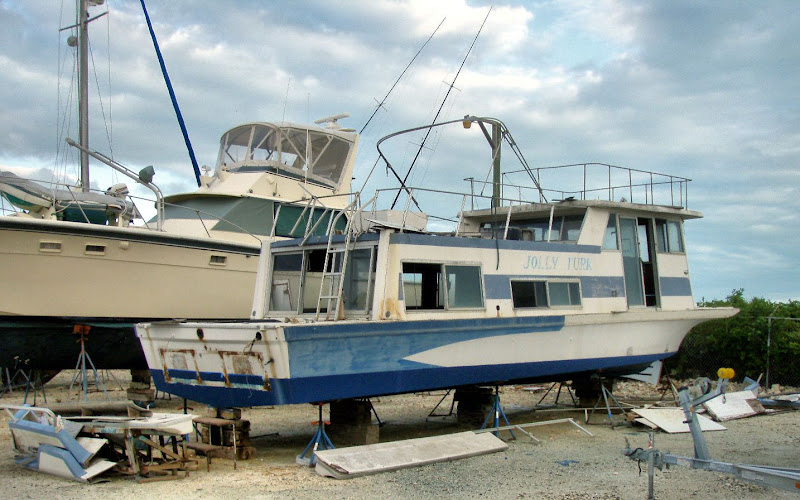
I am pretty sure someone is living on Island Diver full time. The windows are covered over, there are ac units sticking out, solar panels in strange places that would never survive at sea, and a ladder going up the back. It's for sale, though. Might be a cool way to get a vacation home in the islands cheap.
I think La Gringa just liked the name on this one:

I would imagine the Jolly Turk is good for shallow water stuff on the Caicos Bank, but I am not so sure I would want to ride out a storm on it. I get real interested in looking at all the different hull designs, and imagining how the boats will ride in different conditions. They really are all compromises, aren't they.
I have been wondering what our boat would be like with a nice flying bridge on it. I wonder how this rides in the trough outside the reef on a big swell:
I know the inboard will help, keeping the weight down low in the hull. And I wonder how the tabs work close together like that. Still, I bet theres some Dramamine on this boat when he has guests.
Now, this one really caught my eye. I had seen some of these Landing Craft in the water around here, but this is the first one I had been able to see on dry land. Various versions of this boat have been the backbone of remote construction projects here in the islands.
What other kind of vessel would you use over shallow coral reefs and into totally remote areas? The keel extends past the prop and rudder to protect them when grounding the boat:
That drop-down door in the bow has been modified in this one. Originally it had a steel mesh extension sticking up several feet higher.
Here's another view of the keel and rudder setup. This design was developed to protect the propeller in shallow water situations. Which basically describes most of the water around here.
We've been told that a landing craft similar to this one brought the very first motor vehicle to Provo. It was a Jeep CJ, and it came ashore at Heaving Down Rock in Leeward.
There's no name attached to this old workhorse. I get the feeling that it's just not that kind of boat. I became interested in it, and could see a number embossed deeply into the old stern plating.
I would imagine there have been a lot of things painted on this part of the boat, but there's nothing there now except this original designation. It was more than enough to be able to easily read the numbers.
A search of the internet actually led me to some information about this boat.
This appears to be a 36 ft. LCVP (Landing Craft, Vehicle, Personnel) built in 1968 for the US Government. Boy, that year rings some bells. I was still in high school, but several of my friends were already on their way to Viet Nam, the year of the Tet Offensive. Some of you may remember tales of the Imperial City of Hue. A rough time for the USA. The worst year ever in the Viet Nam war.
This LCVP was one of 32 built by a contractor for the government. All 32 of them are listed as being "scrapped". I bet this boat has some tales to tell over the past 40 years, from the US to SE Asia, and ending up in the Turks and Caicos Islands hauling freight. This boat was almost three years old by the time I first saw that part of the world, I wonder if we crossed paths back in the bad old days. Funny we both started and ended in the same places. And it makes me feel about as old as this boat looks.
It looks to me like there is plenty of life left in that boat. Some welding and paint, a little TLC, and it would be good to go.
We had to wonder what the inside accommodations of this vessel looked like, after seeing the way their tastes in bottom paint ran. And that stairway is a work of art in itself.
Some bottom paint works by using a copper compound as a poison to keep marine growth from attaching itself to the hull. But attacking the optic nerves, well, I have to admit that's new one to me. Some fish undoubtedly will abhor it, but I wouldn't be surprised if some others were actually attracted to the motif. There's just no accounting for taste.
We love to hang around boatyards. And some marinas. And small airports, too, come to think of it. There will be more about the airports later in the program.
But eventually dusk comes, or as we refer to it, "0 bug:30" So this time we snapped one last photo through the boatyards travel lift, looking at both the distant sunset, and our house under construction on the far hillside.
As you might imagine, we love this view










1 comment:
Another very nice article and great pictures! I love looking at old boats myself! We see abandoned boats in the marshes here occasionally, but the hulls are mostly rotten after years of neglect!
The old landing craft brings back memories. It makes me wonder if that could have possible been one of the landing craft I was on in Viet-Nam. The Navy used them occasionally to move us Army guys around! I was in Hue right after the main Tet offensive, but plenty of action was still going on, a very dangerous place to be!
Keep up the great work on this blog guys, I am always looking forward to another article and more pictures of the TCI...
Thanks--
Post a Comment